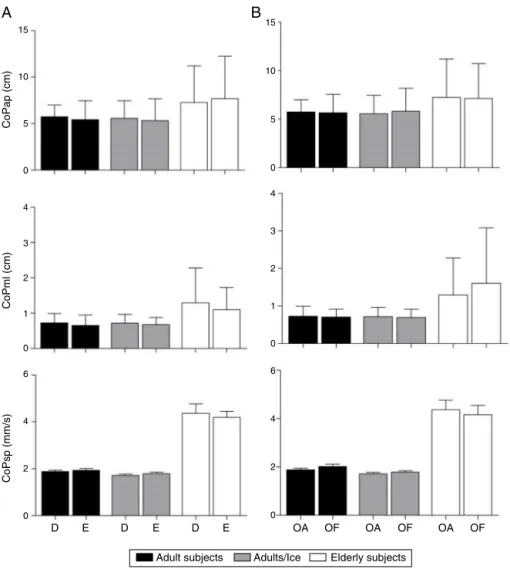ww w . r e u m a t o l o g i a . c o m . b r
REVISTA
BRASILEIRA
DE
REUMATOLOGIA
Original
article
Effects
of
plantar
foot
sensitivity
manipulation
on
postural
control
of
young
adult
and
elderly
Álvaro
S.
Machado,
Caio
Borella
Pereira
da
Silva,
Emmanuel
S.
da
Rocha,
Felipe
P.
Carpes
∗UniversidadeFederaldoPampa,GrupodePesquisaemNeuromecânicaAplicada,Uruguaiana,RS,Brazil
a
r
t
i
c
l
e
i
n
f
o
Articlehistory:
Received25August2015 Accepted24November2015 Availableonline5April2016
Keywords:
Posturalcontrol Balance
Centerofpressure Stability
Aging
a
b
s
t
r
a
c
t
Introduction:Subjectswithsensoriallossespresentbalancedeficits.Althoughsuchcondition isoftenobservedamongelderly,thereisdiscussionconcerningthedependenceonsensorial informationforbodyswaycontrolintheelderlywithoutsensoriallosses.
Purpose:Weinvestigatedtheeffectsoffootsensitivitymanipulationonposturalcontrol duringuprightstandinginyoungadultsandindependentelderly(n=19/group).
Methods:Plantarsensitivitywasevaluatedbyesthesiometry,andspeedofcenterofpressure shiftdataduringuprightposturewereevaluatedforeachfootusingabaropodometerwhile thesubjectswerestandingwitheyesopenorclosed.Theyoungadultgroupwasevaluated forcenterofpressureinnormalconditionsandafterplantarsensitivitydisturbance,by immersingtheirfeetinwaterandice.
Results:Youngadultsdidnotshowalterationsintheircenterofpressureaftersensorial perturbationandpresented,evenundersensorialperturbation,betterposturalcontrolthan elderlysubjects.Theelderlyshowedlowerfootsensitivityandgreatercenterofpressure oscillationthanyoungadults.
Conclusion:Elderlysubjectsseemtorelymoreonfootsensitivityforcontrolofbodysway thanyoungadults.Intheelderly,aclinicalinterventiontoimprovefootsensitivitymayhelp inuprightposturemaintenance.
©2016ElsevierEditoraLtda.ThisisanopenaccessarticleundertheCCBY-NC-ND license(http://creativecommons.org/licenses/by-nc-nd/4.0/).
Efeitos
da
manipulac¸ão
da
sensibilidade
plantar
sobre
o
controle
da
postura
ereta
em
adultos
jovens
e
idosos
Palavras-chave:
Controlepostural Equilíbrio Centrodepressão Estabilidade Envelhecimento
r
e
s
u
m
o
Introduc¸ão:Pessoascomperdassensoriaisapresentamdéficitsdeequilíbrio.Emboraesse quadrosejacomumemidosos,aindasediscuteoquantoidosossemdoenc¸asqueafetam asviassensoriaisdependemdessainformac¸ãoparacontrolaroscilac¸õescorporaisdurante ocontroledapostura.
Objetivo:Investigarosefeitosdaperturbac¸ãodasensibilidadeplantarsobreocontroleda posturaeretaemadultosjovenseidososindependentes(n=19/grupo).
∗ Correspondingauthor.
E-mail:carpes@unipampa.edu.br(F.P.Carpes). http://dx.doi.org/10.1016/j.rbre.2016.03.007
Métodos: Asensibilidadeplantarfoiavaliadacomestesiômetroedadosdevelocidadee deslocamentodocentrodepressãoduranteaposturadepéforamavaliadosparacadapé comumbaropodômetro,emcondic¸õesdeolhosabertosefechados.Ogrupodeadultos jovensfoiavaliadoquantoaocentrodepressãonascondic¸õesnormalepós-perturbac¸ão dasensibilidadeplantar,pelaimersãodospésemáguaegelo.
Resultados: Adultosnão apresentaramalterac¸ões nocentro de pressão em respostaà perturbac¸ãosensorialetiveram,mesmonacondic¸ãodeperturbac¸ãosensorial,melhor con-trolepostural doqueidosos.Idososapresentarammenorsensibilidadeplantaremaior oscilac¸ãodocentrodepressãodoqueosadultosjovens.
Conclusão: Idosospareceramdependermaisdasensibilidadeplantarparamantero con-trole posturaldoqueadultosjovens.Emidosos, intervenc¸õesclínicasquemelhorema sensibilidadeplantarpodemauxiliarnatarefademanteraposturadepé.
©2016ElsevierEditoraLtda.Este ´eumartigoOpenAccesssobumalicenc¸aCC BY-NC-ND(http://creativecommons.org/licenses/by-nc-nd/4.0/).
Introduction
Thecontrolofuprightpostureisaskill requireddailyand whichdependsonconstant neuromuscularadjustmentsto keepthe centerofpressure(CoP)withinthestability limits ofthesupportingbase.1Theseadjustmentssuffer
deteriora-tionbytheagingprocess.2Onereasonfortheoccurrenceof
thesedeficitsmaybethelossofsensoryfunctionor usabil-ityofthissensoryinformation.Whensubjectedtosituations whereproprioceptivefunctionsofthefootandankleare com-promised,youngadultshavealowerlengthandareaofCoP shiftversuselderlysubjects,suggestinganimprovedabilityto compensateforsensoryloss.3,4
Billotetal.5suggestthatplantarsensitivityisnotaprimary
functionforposturecontrolinadults,sincethisinformation canbecompensated byother proprioceptivepathways, for example,visionorvestibularsystem.However,posture con-trol seems to beassociated withplantar sensitivity inthe elderly,whereothersystemsalsohavedeficitsinresponseto aging,forexample,lossesinvestibularsystemfunction,vision andmusclestrength.3Ducicetal.6showedthatthereduced
plantarsensitivity relates todeficits in posturalcontrol of elderlypatientswithperipheralneuropathy.Inaddition, plan-tarsensitivitycontributestothecontrolofplantarpressure duringuprightpostureintheelderly.7Thishelpstoexplain
thefactthatolderpeoplesometimesshowgreaterrelianceon vision,especiallyforthecontrolofCoPvelocity,thanyoung adults.8However,thereisstilldoubtastothedegreeof
con-tributionofthiskindofsensoryinformationfromtheplantar regionfortheregulationofposturalcontrolinhealthyelderly. Experimentalstudieshavedevelopedprotocolsthatreduce temporarilytheadultsensoryfunction,forexample,the activ-ityofmechanoreceptors,inordertomimicsensorydeclineof agingandfacilitateacomparisonbetweenthisintactversus
impairedafferentresource.Onestrategythathasprovedvalid insomestudiesconsistsintheimmersionofthelowerlimbsin waterandice,inordertoreduceplantarsensitivity,two-point touchdiscriminationability,andsensitivitytovibration.9
Inthisstudy,ouraimwastoassesschangesintheposition ofCoPundereachfoot,whichisconsideredasanindicatorof posturalcontrolintheelderlyandinyoungadultsinnormal sensoryconditionandinresponsetoasensitivitydisturbance.
Considering that aging can promote heterogeneous losses indifferentsensorimotor (cognitiveand sensory/perceptual processing)components,10ourhypothesiswasthatreduced
plantarsensitivitywouldexertdifferentimpactfortheelderly comparedtoyoungadults,becauseyoungadultswouldhave thecapacitytoregulateCoPsatisfactorily,evenunder condi-tionsofdisturbanceinthesensorycharacteristicsoftheirfeet, indicatingthatthistypeofinformationismoreimportantfor theelderlythanforyoungadults.
Materials
and
methods
Participants
Thirty-eight participantsinvitedfrom the localcommunity were dividedinto twogroupsmatchedforheightand body mass.Thegroupofyoungadultsincluded19subjectswith mean(SD)ageof35(5)years,heightof1.65(0.08)m,andbody massof63(10)kg. Theelderly groupconsistedof19 inde-pendentelderlysubjectswithmean(SD)ageof79(6)years, heightof1.55(0.05)m,andbodymassof68(9)kg.Thegroup ofyoungadultswasevaluatedintwoconditions:onepre-and theother post-sensorydisturbance,makingatotalofthree groupsinthefinalanalysis:adultswithoutsensory disturb-ance,post-sensorydisturbanceadults,and elderlysubjects. All participants signedaninformed consentin accordance withtheDeclarationofHelsinkiandthisstudywasapproved bytheHumanResearchEthicsCommitteeofthelocal institu-tion(opinion082011).Allparticipantsoughttobeinaphysical conditiontowalkandtostandontheirownfeetwithno ortho-sisorprosthesis;moreover,theyshouldbeavailabletovisit thelaboratorytobepartoftheevaluations.Exclusion crite-riaincludedthepresenceofcerebellardisease,plantarskin lesions,lower limbtraumatic injuryhistory, neuropathy or inabilitytoperformtheproposedtasks.
Assessmentofplantarsensitivity
Fig.1–Illustrationofthepointswhereplantarsensitivitywasevaluatedandtheesthesiometerusedinthestudy.
(Semmes-WeinsteinMonofilaments,SanJose,USA).11,12 The
esthesiometerconsistedof6nylonfilamentsofequallength (Fig.1A)withvaryingdiameters,abletoproducea standard-izedpressureontheskinsurface(consideringsixvaluesfrom 0.05gfto300gf)inaccordance withcalibrationand recom-mendationforuse.13
Duringtheassessment,allparticipantswere blindfolded and in a supine position in a quiet and distraction-free environment. All participants were evaluated by the same evaluator.Plantarsensitivitywasevaluatedinninedifferent locationsofthefoot(Fig.1A)inarandomizedorder,withan alternationoffeetintheevaluationofeachparticipant. Partic-ipantsindicatedintheirpalmtheareawheretheyperceived thetactilestimulus ontheirfeet.All evaluationswere per-formedinthesameperiodoftheday.Plantarsensitivitywas determinedbytheinitialapplicationofthethinfilaments, pro-gressingtothethickfilamentsuntiltheparticipantwouldbe abletodetectthetouch.14Thesetoucheswereperformed
dur-ing1secondandwithtworepetitions,sothatthefilament wouldtakeaC-shapedform.
Eachfilament corresponded toa classificationbasedon theircolors,inwhichgreenandbluecorrespondstoanormal sensitivity;violetcorrespondstosomedifficultyofshapeand temperaturediscrimination;reddenotesslightlossofa vul-nerabletoinjury,protectivesensation;orangedenotesaslight lossofprotectivesensation;pinkdenoteslossofprotective sensationandnoresponseatall.
Todeterminethesensitivityoftheentirefoot,thesumof thevaluesforeachregionwascalculated.Thus,thehigherthe score,thelowertheplantarsensitivity.
Posturalcontrolassessment
DataacquisitionfortheevaluationofCoPwasmadeduringthe standingposturewithbipedalsupport,feetpositionedinan
abductionof30◦ 15withtheheelskept5cmapartandarms relaxed besidetheupperbodyintwosituations:(a)looking towardafixedpoint4metersaheadandateyelevel;(b)with closedeyes.3
Foreachvisualcondition,threeattemptsof30seachwere made,thefirstconditionalternatingbetweenopenandclosed eyesineachparticipantassessed.Forallparticipants,a 30-second interval was observed between attempts. CoP data werecollected foreachfootwiththeuse ofa baropodome-ter(TekscanInc.,Boston,MA),withasamplingrateof100Hz The following variables were measured: average speed of CoP(CoPsp),anteroposterior(CoPap)andmediolateral(CoPml) amplitude,consideringthecontactareaofeachfootwiththe surface.
Plantarsensitivitydisturbance
Theplantarsensitivitydisturbanceprotocolwasappliedonly toyoungadultparticipants,andaimedtosimulateasensory decreaseinfootarea–acommonfindingintheelderly.The disturbance protocol was conducted through hypothermia, similar to the protocol previouslyused.9,16 For the
genera-tionofthedisturbanceinordertoobtaintheplantarsensorial information,participantscompletedthe protocolina com-fortable sitting position and kept theirfeet immersed ina container with iceand water, at a controlled temperature between 5◦C and 8◦C for 15min.3 For the evaluation of CoPafterimmersioninice,participantsmovedimmediately fromthepositiondescribedtothestandingpositiononthe baropodometer.
Dataanalysis
Table1–Plantarsensitivityscores(dataexpressedasmeanandstandarddeviation)ineachfoot.Thesumofallpoints
foreachfootrepresentsthesensitivityofthewholefoot.Highervaluesrepresentworsesensitivity.
Youngadults Theelderly
Rightfoot Leftfoot Rightfoot Leftfoot
Mean 24.7 25.2 46.2a 46.6a
Standarddeviation 4.0 5.3 12.1 14.1
a Statisticallysignificantdifferenceamonggroupsverifiedbypairedttest(p<0.05).
Plantarsensitivitywascomparedbetweenrightandleftfeet ofyoung adultsusing the paired t test; in the elderly, the Wilcoxontestwasapplied.Theindependentttestwasused tocomparegroups.Toobtainananalysisofasymmetriesand theeffectofvisiononCoPdata,forallgroupsandconditions theWilcoxontestwasused.FromCoPmeasurements,young adults,post-sensory disturbanceyoung adults, and elderly groupswerecomparedbyanalysisofvariance,withthepost hocBonferronitest.Inalltests,a0.05significancelevelwas set.
Results
Thenormalitytestforsensitivityshowedaparametric dis-tribution in young adults for the right (p=0.064) and left (p=0.177)leg; andforthe elderly,a parametricdistribution forthe right leg (p=0.175), and a non-parametric distribu-tionfortheleftleg(p=0.018)wereobserved.Thesensitivity data were analyzed only for the right foot, as there were no asymmetries in these observations in young adults [t
(18)=–0.529;p=0.603]andintheelderly[Z=–0.393;p=0.694]. Theplantarsensitivityresultsshowedthatyoungadultshad abettersensitivity than theelderly forboth feet(Table 1). As to the analysis of CoP (Fig. 2), it was found that the visualdeprivation didnotchange any variable ofCoP; fur-thermore, no asymmetries were observed (Fig. 3). Thus, subsequentcomparisonswere performedusingdataofthe analysisoftrialswitheyesopenandusingdatafromtheright foot.
AnalyzingtheamplitudeofCoPshift,agroupeffectwas not observed in the anteroposterior direction [F(2)=2.348;
p=0.105]. On the other hand, in the assessments of CoP shift in the mediolateral direction, a group effect was observed [F(2)=5.622; p=0.006]. The post hoc analysis indi-cated similarity among young adults versus young adults after sensory disturbance(p=1.000). However, elderly sub-jects had greater mediolateral shift of CoP versus young adults(p=0.017),andyoungadultsaftersensorydisturbance (p=0.015).
In the same line, a group effect was observed for CoP speed[F(2)=7.587;p=0.001].Thepost hocanalysisindicated thatthegroupofyoungadultsaftersensorydisturbancewas notdifferentfromthe“withoutsensorydisturbance” condi-tion(p=1.00).However,youngadultspriorto(p=0.006)and after(p=0.003)plantarsensitivitydisturbanceshowedlower valuesversustheelderly.
10 5
*
*
4
3
2
1
0
Amplitude (cm)
Adult subjects Adults/Ice Elderly subjects
Speed (mm/s)
CoPap CoPml CoPsp
8
6
4
2
0
Fig.2–CoPamplitudevaluesinanteroposterior(CoPap)
andmediolateral(CoPml)directions,incentimeters,onthe
leftverticalaxis,andCoPspeed(CoPsp)inmillimetersper
second(mm/s)ontherightverticalaxisforeachgroup
(n=19pergroup).*Itindicatesstatisticallysignificant
differencebetweengroups,confirmedbyananalysisof
variancewithposthocBonferroni(p<0.05).
Discussion
Trying to simulate in young adults the losses in plantar sensitivityexperiencedbythe elderly,weconducteda sen-sitivitydisturbanceprotocolforplantarsensitivityinyoung adults.Althoughthissamesensorydisturbanceprotocolhas generatedchangesinplantarsensitivityofadultsina previ-ousstudy,3,9 theimpactofthisacutedisturbancecannotbe
regardedasequivalenttothatexperiencedbytheelderly,in whomthesedeficitsarepresentinacontinuousand progres-sivemanner.11However,thisisnotaspecificlimitationofour
study,butofallstudieswhichseektoinvestigatethistypeof question.Inaddition,differencescanalsodependonthe abil-ityofadultstouseinformationcomingfromotherafferent pathways,possiblythevestibularsystem,tocontrolCoP.17
A
CoPap (cm)
CoPml (cm)
CoPsp (mm/s)
15
10
5
0
4
4
3
3
2
1
0
D E D E D E OA OF OA OF OA OF
Adult subjects Adults/Ice Elderly subjects
6 6
4
2
0
4
2
0 2
1
0 15
10
5
0
B
Fig.3–Mean(bars)andstandarddeviationofanteroposterioramplitudeofthecenterofpressure(CoPap)andmediolateral
amplitudeofthecenterofpressure(CoPml)incentimeters,andcenterofpressureshiftspeed(CoPsp)foreachgroup(n=19
pergroup)inmillimeterspersecond(mm/s).Theleftcolumn(columnA)displaysvaluesforbothfeet,whereRindicates
rightfootandLindicatesleftfoot.Intherightcolumn(columnB),valuesarepresentedforvisualconditionswithopeneyes
(OE)andclosedeyes(CE).Forbothanalysisofcomparisonbetweenrightandleftfoot,theWilcoxontestwasused,witha
significancelevelof0.05.
plantarsensitivitytomaintainbalanceinthestanding pos-ture, andold age leads toanincreased bodysway.18 Ueda
etal.3foundanincreaseinanteroposteriorshiftofCoPofthe
wholebodyintheelderly,comparedtoyoungadults,andour evaluationofCoPforeachfootshowedthatthemediolateral amplitudeofCoPisgreaterinoldersubjectsthaninyoung adults(withor withoutsensory disturbance).Thisresultis relevant,sincethemeasurementofthemediolateral ampli-tudeisimportantforpredictingtheriskoffallsintheelderly population19;thus,ourresultisanindicatorofvulnerability
tofallsinelderlypatientswithcompromisedplantar sensi-tivity.ThesamehappenedwithCoPvelocity,whichremained higherinelderlyversusyoungadultsbeforeandaftersensory disturbance,meaningaworseperformanceincontrollingthe standingposture.ThisvariableisdescribedbyHewsonetal.20
asbeingusefulintheclassificationofelderlypeoplewithand withoutriskoffalls.Again,wefindavariablethatcanindicate
thenegativeinfluenceofreducedsensitivityonthestability oftheelderly.
Ourresultscorroboratethefindingsofarecentstudy21that
also foundnoincrease inCoP shiftswhen visual informa-tionwasnotavailable,orwithdisturbanceofthesensitivity ofadultfeet.22Thisrecentstudyhasshownthatsole
Yasudaetal.17pointoutthatthemajormechanism
con-tributingtothecontroloforthostaticpostureisthevestibular system.Knowingthatthissystemisimpairedwithadvancing age,23itcanbeinferredthatadultsgetbetterposturalcontrol
valuesthattheelderlybecause,evenwiththedeprivationof visionandinascenarioofplantarsensitivitydisturbance,the youngadultsmaintainedabodyadjustmentsysteminbetter condition.Ontheotherhand,knowingthatvestibular prob-lemsareoneofthemostcommon causesofdizzinessand imbalanceinthe elderly,24 andconsideringthatthelossof
plantarsensitivityinelderlypeopleisrelatedtothegreater fluctuationoftheCoP,itmaybesuggestedthatinterventions thataimtomaintainorreducelossesinplantarsensitivitycan helpmaintainingposturalbalancetocompensatefor compro-misesinCoPundertheacuteeffectofthedisturbance.We didnotevaluatepost-hypothermiasensitivitybecause stud-iesshowthattheeffectoftheimmersionofthefeetinwater andiceonposturalcontrolcanbecompensatedforshortly afterthe endofthe immersion.9 Anevaluationof
sensitiv-ityafter immersionin waterandicewould require atime thatwould cancelthe effectsof sensorychange sought by ourgroup.Ontheotherhand,otherstudieswerepublished indicatingthat thistype ofprotocol iseffective forplantar sensitivitydisturbance.12,25 Inourstudy,weconsideredthe
measurementofCoPineachfoot,becausethedetermination ofplantarsensitivityisdoneoneachfoot.Whilethismaynot bealimitation inourdiscussion, ourprocedurestillleaves roomforaninvestigationthatalsomonitortheshiftofthe centerofgravity,allowingabroaderviewofposturalstability inresponsetodisturbancesinplantarsensitivity.
Conclusion
Theelderlyandyoungadultsdifferinrelationtotheir depend-enceonplantarsensitivityinordertomaintaintheupright posture,onthebasisofCoPmeasures,whereintheplantar sensoryinformationappearsmoreimportantfortheelderly.It ispossiblethatclinicalinterventionsthatimprovetheplantar sensitivityintheelderlycancontributetoimprovethecontrol oforthostaticposture.
Funding
FAPERGS(process1013100).
Conflicts
of
interest
Theauthorsdeclarenoconflictsofinterest.
r
e
f
e
r
e
n
c
e
s
1. WinterD.Biomechanicsandmotorcontrolofhuman movement.4a
ed.JohnWiley&Sons;1990.p.370. 2. FreitasSM,WieczorekSA,MarchettiPH,DuarteM.
Age-relatedchangesinhumanposturalcontrolofprolonged standing.GaitPosture.2005;22(4):322–30.
3.UedaLS,CarpesFP.Relac¸ãoentresensibilidadeplantare controleposturalemjovenseidosos.RevBrasCineantropom DesempenhoHum.2013;15(2):215–24.
4.SchleeG,SterzingT,MilaniTL.Footsoleskintemperature affectsplantarfootsensitivity.ClinNeurophysiol. 2009;120(8):1548–611.
5.BillotM,HandriganGA,SimoneauM,CorbeilP,TeasdaleN. Shorttermalterationofbalancecontrolafterareductionof plantarmechanoreceptorsensationthroughcooling. NeurosciLett.2013;535:40–4.
6.DucicI,ShortKW,DellonAL.Relationshipbetweenlossof pedalsensibility,balance,andfallsinpatientswith peripheralneuropathy.AnnPlastSurg.2004;52(6): 535–610.
7.ZhangS,LiL.Thedifferentialeffectsoffootsolesensoryon plantarpressuredistributionbetweenbalanceandgait.Gait Posture.2013;37(4):532–7.
8.PrietoTE,MyklebustJB,HoffmannRG,LovettEG,Myklebust BM.Measuresofposturalsteadiness:differencesbetween healthyyoungandelderlyadults.IEEETransBiomedEng. 1996;43(9):956–66.
9.StalF,FranssonPA,MagnussonM,KarlbergM.Effectsof hypothermicanesthesiaofthefeetonvibration-induced bodyswayandadaptation.JVestibRes.2003;13(1): 39–41.
10.AngueraJA,GazzaleyA.Dissociationofmotorandsensory inhibitionprocessesinnormalaging.ClinNeurophysiol. 2012;123(4):730–40.
11.PerrySD.Evaluationofage-relatedplantar-surface
insensitivityandonsetageofadvancedinsensitivityinolder adultsusingvibratoryandtouchsensationtests.Neurosci Lett.2006;392(1–2):62–7.
12.PatelM.Foamposturography:standingonfoamisnot equivalenttostandingwithdecreasedrapidlyadapting mechanoreceptivesensation.ExpBrainRes.
2011;208(4):519–25.
13.HolewskiJJ,StessRM,GrafPM,GrunfeldC.Aesthesiometry: quantificationofcutaneouspressuresensationindiabetic peripheralneuropathy.JRehabilResDev.1988;25(2): 1–10.
14.FengY,SchlosserFJ,SumpioBE.TheSemmesWeinstein monofilamentexaminationasascreeningtoolfordiabetic peripheralneuropathy.JVascSurg.2009;50(3):
675–82.
15.AzziNM,CoelhoDB,TeixeiraLA.Efeitodaposic¸ãodospésna recuperac¸ãodoequilíbrioapósperturbac¸ão.AnaisdoVSNA. 2014;1:88–93.
16.KunzlerMR,LopesLM,UedaLS,deBrittoMA,CarpesFP.Does skinstimulationcompensateimpairmentsinposturalcontrol afterankleplantarflexorsfatigue?GaitPosture.
2013;37(4):611–5.
17.YasudaT,NakagawaT,InoueH,IwamotoM,InokuchiA.The roleofthelabyrinth,proprioceptionandplantar
mechanosensorsinthemaintenanceofanuprightposture. EurArchOtorhinolaryngol.1999;256(1):27–32.
18.LordSR,WardJA.Age-associateddifferencesin
sensori-motorfunctionandbalanceincommunitydwelling women.AgeAgeing.1994;23(6):452–60.
19.BrauerS,BurnsY,GalleyP.Lateralreach:aclinicalmeasureof medio-lateralposturalstability.PhysiotherResInt.
1999;4(2):81–8.
20.HewsonDJ,SinghNK,SnoussiH,DucheneJ.Classificationof elderlyasfallersandnon-fallersusingCentreofPressure velocity.IEEETransBiomedEng.2010;2010:3678–81. 21.BillotM,HandriganGA,SimoneauM,TeasdaleN.Reduced
22.HafstromA,FranssonPA,KarlbergM,LedinT,MagnussonM. Visualinfluenceonposturalcontrol,withandwithoutvisual motionfeedback.ActaOtolaryngol.2002;122(4):392–9. 23.MathesonAJ,DarlingtonCL,SmithPF.Dizzinessintheelderly
andage-relateddegenerationofthevestibularsystem.NZJ Psychol.1999;28(1):10–6.
24.IwasakiS,YamasobaT.Dizzinessandimbalanceinthe elderly:age-relateddeclineinthevestibularsystem.Aging Disease.2015;6(1):38–47.


